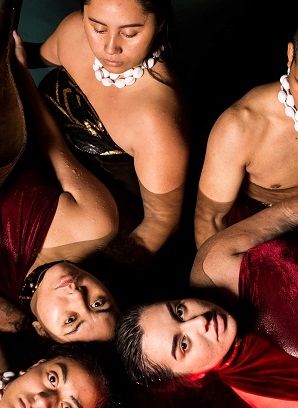Kapu Akari (Pacific Dance Festival)
The audience enters and awaiting our arrival are 10 performers in a meditative state, dressed in white, high-waisted, long skirts and neutral turtle necks. Stage right, mustard cloths tied together are hanging from the ceiling and reaching the floor into a kava bowl. The audience, respectfully, wait for the piece to begin. I’m transfixed listening to the slow, idling sounds that pulse from the speakers. I’m aware of everyone in this space, not saying a word, breathing and listening to what’s happening around us. It doesn’t feel awkward, it feels like now is the only time and I’m in the right place. A beautiful start to the show. The music changes gear as the house lights transition and suddenly we are watching a woman move.
The first section of the piece seems to take a while to get somewhere, with each cast member repeating a slight variation of the gestural choreography. Swiping away from themselves with their hands and making sound through their teeth. The transition to reveal a man centre stage was surprising and very well executed. The lights change red and we are able to see some bigger movements and sequences begin. The lighting throughout the show was seamless and effective, often throwing our attention to specific lines and shapes. Like the single sectioned squares created on the floor, I enjoyed how this was used to help represent the idea of death to us. The soundtrack was dynamic, mixing vocal sections, soundscape, cultural rhythms, and uplifting beats. I didn’t find my attention wavering too many times, I was engaged, however, I wasn’t immersed in the world of the piece. I was aware that I was watching people on stage move. I feel the use of voice in different sections aided in this idea. Yes, we were watching stories be told through movement but they also had a voice to tell these stories too, it was a nice detail.
While I could follow and appreciate some aspects and ideas of Kapu Akari and its multitude of cultural meanings and representations (tradition, rituals, Created from), I found there were too many different thoughts to be able to follow cohesively. Each progressing section seemed to explore something different, but I wasn’t able to really connect with it, other than to appreciate the pleasing aesthetics that were created and being displayed. Maybe that is my own naivety or maybe this is because I wasn’t convinced by each performer. Unfortunately, in pockets, the performers seemed to lack the strength to finish movements convincingly. Two performers did stand out for me though and I am unable to identify them from the programme. I use my description as, the young female dancer with two Dutch braids and a fringe, and the young male performer. Both had something extra that my eye was drawn to; crisp in their movements and fluid when necessary. In particular, the young male’s solo, while the women sat watching at his feet, was lovely to experience. I look forward to seeing where this dancer goes next. I also enjoyed the two women who performed a Cook Island dance before being derobed.
I understand how many hours go into making a work like this. Endless, endless hours. But I’m hesitant to say that this was a brilliant show. I did enjoy watching it, but I wasn’t wowed, nor could I find an overall X-factor quality. Yet I would happily attend another showing of Kapu Akari, to see if and how the ideas and processes may change.

